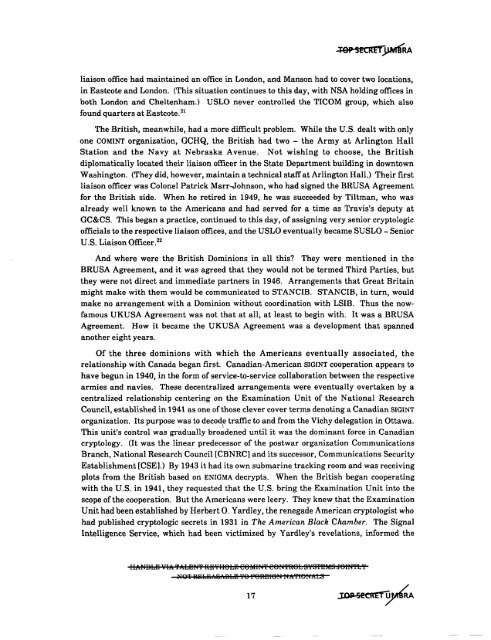American Cryptology during the Cold War - The Black Vault
American Cryptology during the Cold War - The Black Vault
American Cryptology during the Cold War - The Black Vault
Create successful ePaper yourself
Turn your PDF publications into a flip-book with our unique Google optimized e-Paper software.
liaison office had maintained an office in London, and Manson had to cover two locations,<br />
in Eastcote and London. (This situation continues to this day, with NSA holding offices in<br />
both London and Cheltenham.) USLO never controlled <strong>the</strong> TICOM group, which also<br />
found quarters at Eastcote. 21<br />
<strong>The</strong> British, meanwhile, had a more difficult problem. While <strong>the</strong> U.S. dealt with only<br />
one COMINT organization, GCHQ, <strong>the</strong> British had two - <strong>the</strong> Army at Arlington Hall<br />
Station and <strong>the</strong> Navy at Nebraska Avenue. Not wishing to choose, <strong>the</strong> British<br />
diplomatically located <strong>the</strong>ir liaison officer in <strong>the</strong> State Department building in downtown<br />
Washington. (<strong>The</strong>y did, however, maintain a technical staffat Arlington Hall.) <strong>The</strong>ir first<br />
liaison officer was Colonel Patrick Marr-Johnson, who had signed <strong>the</strong> BRUSA Agreement<br />
for <strong>the</strong> British side. When he retired in 1949, he was succeeded by Tiltman, who was<br />
already well known to <strong>the</strong> <strong>American</strong>s and had served for a time as Travis's deputy at<br />
GC&CS. This began a practice, continued to this day, ofassigning very senior cryptologic<br />
officials to <strong>the</strong> respective liaison offices, and <strong>the</strong> USLO eventually became SUSLO - Senior<br />
U.S. Liaison Officer. 22<br />
And where were <strong>the</strong> British Dominions in all this? <strong>The</strong>y were mentioned in <strong>the</strong><br />
BRUSA Agreement, and it was agreed that <strong>the</strong>y would not be termed Third Parties, but<br />
<strong>the</strong>y were not direct and immediate partners in 1946. Arrangements that Great Britain<br />
might make with <strong>the</strong>m would be communicated to STANCIB. STANCIB, in turn, would<br />
make no arrangement with a Dominion without coordination with LSIB. Thus <strong>the</strong> nowfamous<br />
UKUSA Agreement was not that at all~ at least to begin with. It was a BRUSA<br />
Agreement. How it became <strong>the</strong> UKUSA Agreement was a development that spanned<br />
ano<strong>the</strong>r eight years.<br />
Of <strong>the</strong> three dominions with which <strong>the</strong> <strong>American</strong>s eventually associated, <strong>the</strong><br />
relationship with Canada began first. Canadian-<strong>American</strong> SIGINT cooperation appears to<br />
have begun in 1940, in <strong>the</strong> form of service-to-service collaboration between <strong>the</strong> respective<br />
armies and navies. <strong>The</strong>se decentralized arrangements were eventually overtaken by a<br />
centralized relationship centering on <strong>the</strong> Examination Unit of <strong>the</strong> National Research<br />
Council, established in 1941 as one of those clever cover terms denoting a Canadian SIGINT<br />
organization. Its purpose was to decode traffic to and from <strong>the</strong> Vichy delegation in Ottawa.<br />
I<br />
This unit's control was gradually broadened until it was <strong>the</strong> dominant force in Canadian<br />
cryptology. (It was <strong>the</strong> linear predecessor of <strong>the</strong> postwar organization Communications<br />
Branch, National Research Council [CBNRC] and its successor, Communications Security<br />
Establishment [CSE].) By 1943 it had its own submarine tracking room and was receiving<br />
plots from <strong>the</strong> British based on ENIGMA decrypts. When <strong>the</strong> British began cooperating<br />
with <strong>the</strong> U.S. in 1941, <strong>the</strong>y requested that <strong>the</strong> U.S. bring <strong>the</strong> Examination Unit into <strong>the</strong><br />
scope of<strong>the</strong> cooperation. But <strong>the</strong> <strong>American</strong>s were leery. <strong>The</strong>y knew that <strong>the</strong> Examination<br />
Unit had been established by Herbert O. Yardley, <strong>the</strong> renegade <strong>American</strong> cryptologist who<br />
had published cryptologic secrets in 1931 in <strong>The</strong> <strong>American</strong> <strong>Black</strong> Chamber. <strong>The</strong> Signal<br />
Intelligence Service, which had been victimized by Yardley's revelations, informed <strong>the</strong><br />
IIANBLB VIA "ALElN" IlElYII8LEl e8MIN" e8fffft8L SYS'fF.lMStf8In'f'bY<br />
17
















